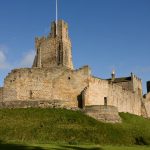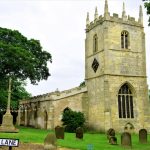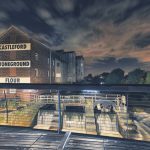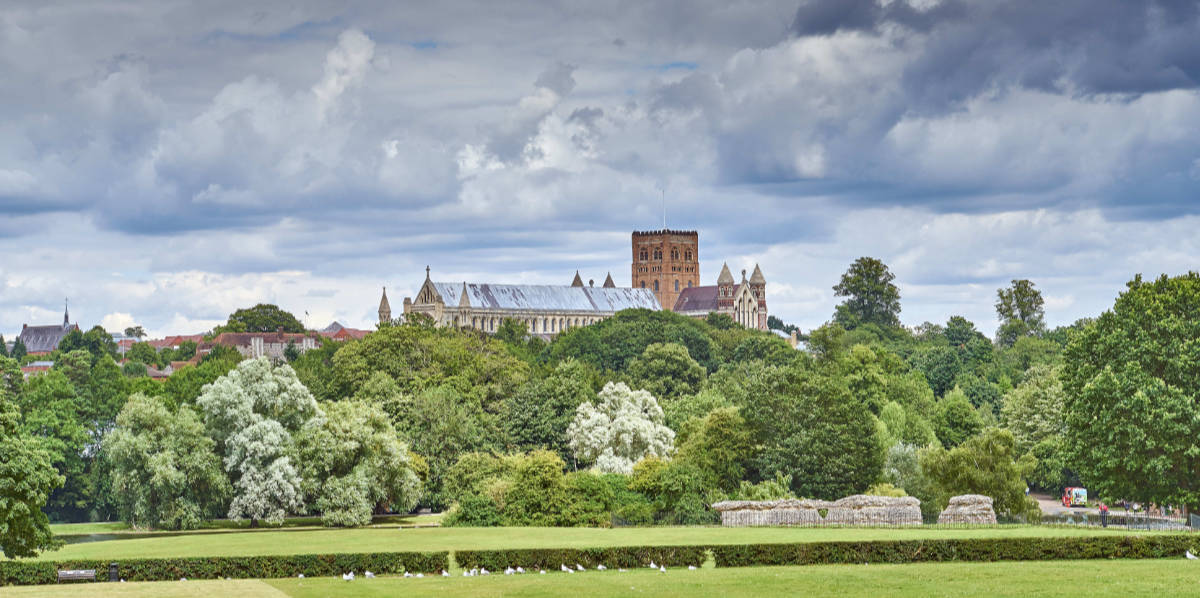
St Albans. The ideal staycation base for those with a love of history or Hot Cross Buns.
Buns we hear you ask, well read on and we will get to that bit. But seriously if you are in Hertfordshire or London for that matter then you really need to consider paying a visit to this former Celtic capital. Its history is long and illustrious history and over the years it has grown to become a sizable city and gain a cathedral. Being around 20 miles from London it has also become a popular commuter town, however that has not soiled its charm too much that also means that anyone using the city as a base has numerous attractions to choose from both locally and in the vicinity.
The city also has a football team for those who follow the lower league game and there are all the modern amenities one would expect from a location of its stature. Ok, preamble aside let’s get on with the guide, starting with a quick history lesson…
Early St Albans
There have been people living in St Albans since the Iron Age. There was a settlement nearby, which would have rested at the current settlement of Prae Hill. When the Romans invaded in 43AD, they took over the town and caused significant damage. Up until that point, the city was named Verulamium. This is taken from the Celtic words for “the settlement on top of the marsh”.
It was during these early centuries that Saint Alban himself was said to have lived here. between the 3rd and 4th centuries, Saint Alban sheltered a Christian priest at his home within the city. When the Romans came hunting the priest, Saint Alban donned the priestly robes himself and was taken for execution. Christian mythology has it that a spring sprang up where his head was chopped off. He became one of the earliest British Saints. Saint Alban was executed in 304AD.
The Romans Take Over
The town of Verulamium, as the Romans called it, grew in importance in the eyes of the Roman Empire. There has been evidence uncovered of trade and of settlements that existed 50 years before Julius Caesar invaded Britain. Excavations performed in 1996 found silver coins from the Roman Republic era, which would have been around 90 BC. Before the Romans arrived, St. Albans would have been nothing more than a town full of wooden huts with thatched roofs. There may have been a ditch and an earth rampart, which would have given the townsfolk some protection from any invaders. Unfortunately, this wasn’t enough to keep the Romans out.
Boudicca burned St Albans in 61AD when she went on a rebellion throughout the country. The town was quickly rebuilt but wooden buildings were replaced with stone ones. There have been temples to the Roman gods uncovered in St. Albans. There was a theatre which seated nearly 6000 people. In the 3rd century, those earthen ramparts were replaced with strong stone walls. Under the Roman Empire, St. Albans prospered.
And then they were gone
The last of the Roman soldiers evacuated British shores around about the beginning of the 5th century. By 407AD they were mostly gone. Some few would have stayed behind, having started families in the area. Their bloodlines would add to the already diverse mix of people that would eventually form the English nation. However, St. Albans itself would have been largely abandoned.
Saxons came next invading from Germany, they would have arrived before the 7th century. An Abbey grew up in the area in the late 8th century. The village that grew up around the Abbey became known as St. Albans. By the time the village had grown up, the population was strictly Anglo-Saxon. The Germans that invaded a century before then had converted to Christianity. In 1978 an excavation by archaeologists expecting to find Roman ruins instead found a mediaeval chapter house which was dated to the 8th century. It is possible that two separate towns existed for a period in the 8th century.
St Albans during mediaeval times
The mediaeval town grew up around the Benedictine Abbey of Saint Albans, which was founded in 793. It was the principal Mediaeval Abbey in England. The Magna Carta was first drafted inside this Abbey. It became a parish church in 1539 when Henry the eighth decided to go on a war against the church. In 1877 it was finally turned into a cathedral and given the status that it truly deserved.
For centuries St. Albans was overshadowed by the nearby town of Kingsbury. Sometime in the 10th century, one of the Abbots from the Saint Albans Abbey decided to enlarge the town. He brought in new settlers and bought them new building materials. He also began running a weekly market. Not so nice, that same Abbott bought the large fish pool from Kingsbury, which was where most of them made their money. He drained the pool, thereby taking away the main source of revenue from the area. This forced residents of Kingsbury to move on to St. Albans where there was food and work. The Abbot got his wish of a larger town, but at what cost?
This was nothing compared to his successor, which bought the entire turn of Kingsbury in the 11th century. He bought it specifically to level it flat. Any remaining residents moved to Saint Albans. He even had the roads diverted so that more people would pass through the town.
The Doomsday Book
At the time of the Domesday Survey conducted in 1086, St. Albans was one of the largest 20% of settlements recorded. By this point, it only had one owner and that was the Abbey of Saint Albans. All the land around the town belonged to the Abbot. He owned 16 ploughlands, with two Lords plough teams and one Lords Plough team extra. There were 13 men’s plough teams to plough those fields. The Abbot owned two ploughs, woodland containing 1000 pigs, 3 mills and 1 fishery. In 1086 the land was worth £20, which was a princely sum in those days.
It is estimated that the 14th century in Albans had a population of 1300 people. By 1077, the new Abbot demolished the old Abbey and rebuilt it. It is thought that the rebuild was further downhill than the old one. The town would have been a haven for carpenters and blacksmiths, leatherworkers and bakers. Cattle and swine would have been traded from the surrounding local countryside. The primary fabric used would have been wool, which would have been dyed here.
Mediaeval St. Albans had problems of its own though. Nobody liked that the Abbot owned the town. Frequent arguments are reported between the Abbot and the townspeople throughout the Middle Ages. Nevertheless, the town grew in importance until it held one weekly market and three annual fairs.
What Time Is It
In the year 1403, Thomas Wolvey was hired to create a clock tower for the marketplace. The original bell weighed a full tonne. It sounded at 8:00 or 9:00 PM every night for the curfew imposed by the Abbey. Around the same time the pub, Ye Olde Fighting Cocks was opened. It claims to be the oldest pub in all of England. The Bishops of Hertford and of St Albans would have had their palaces on Abbey Mill Lane.
2 battles took place within the walls of Saint Albans during the War of the Roses. The Yorkists and the Lancastrians fought two battles here, one in 1455 and one in 1461.
Let’s take a historical break for a moment and turn our attention to some fun facts about Saint Alban’s.
Fun facts and trivia about St Albans.
We have reached that time of the article again. At this point, we like to recap some of the funniest things to have happened in and around the towns we are reviewing. Let’s take a look at what gossip we could dish up about Saint Albans.
Some fun facts about Saint Albans include:
- The German Zeppelin SL11 was the first-ever airship to be brought down above England during the First World War.
- Stephen Hawking studied at St. Albans School back in 1952. He also attended the St. Albans High School for Girls for a few months, back when young boys could attend it too.
- There has only ever been one English Pope. Pope Adrian the 4th studied at the Abbey School in Saint Albans before he went on to become Pope on December 4th, 1154.
- The last time the bell in St. Albans was rung, was for Queen Victoria’s funeral in 1901.
- Brother Thomas Rodcliffe, then a monk at St Albans Abbey, is credited with inventing the Hot Cross Bun! Originally called an ‘Alban Bun’ he began giving them out to the needy on Good Friday 1361

Image:
By Natasha Breen/Shutterstock.com
Now that we have got to grips with some of the fun facts from Saint Albans, let’s take a look at the rest of the history. Several interesting things happened here before any of us were even born. Let’s find out what.
The later period
The Abbey finally closed in 1539, much to the delight of the residents. This meant the loss of tourists and pilgrims to the town, but it also meant that the Abbot no longer ruled everything. St. Albans gained its first charter in 1553, which allowed it to officially have a market in the eyes of the king.
1604 saw a terrible outbreak of plague in Saint Albans. And 1642 another civil war erupted between the king and the parliament. The parliamentarians were led by Oliver Cromwell, who would later attack St Albans, which was still loyal to the king. In 1643, the High Sheriff of Hertfordshire also attacked the town but was captured. The town remained parliamentarian until the end of the war, but the townsfolk erected an earthen defence for their own benefit.
In the 17th century, a writer described the town as having a very large street to the marketplace but as being pretty. There is nothing much worth mentioning to have happened in Saint Albans until the start of the industrial revolution in the 18th and 19th centuries. By the start of the 1800s, the population was around 3500 people. And the end of the 18th century London Road was rebuilt to widen it for the now copious traffic. Almshouses were opened in 1736 and in 1735 someone was appointed to clean the streets.
St Albans The Silk Town
In 1802 a silk mill was opened to complement the numerous cotton mills in the area. Straw hat making was popular in Saint Albans for a while, but it had already gone into decline at the start of the Industrial Revolution.
Gas St lighting was added at the start of the 19th century. A town hall was built and the first police force in Saint Albans was formed in 1836. As the population continued to explode, a Corn Exchange was opened, and St. Albans gained proper piped water. There weren’t any sewers yet, so there would still be outbreaks of plague.
The railway arrived in Saint Albans in 1868, which was quite late. The Stagecoach Inn went into decline as a result, but the population skyrocketed, and the boundaries of the town had to be extended.
In 1877 the Abbey Church of St Albans became a cathedral and of course, it remains a major tourist attraction to this day. This coincided with St Albans gaining city status the added a Public Library in 1896, and a museum in 1899 just in time for the new century dawning.
2oth Century St Albans
By 1900 the population had quadrupled to 16,000, some rise considering it was around 4000 at the start of the 19th century.
The Cinema was built in 1908, followed by buses added in 1909.
As we know, the First World War saw the first-ever zeppelin brought down above Britain to land in St Albans. However, this didn’t stop the numerous deaths of young men from the area. The role of honour for Saint Albans includes 634 names of men who died on the front lines. As an added blow, the First World War saw Britain participate in the buddy regiment scheme. This programme saw thousands of young men from the same area go off to war together.
The first Council houses weren’t built until the 1920s, but later more would be added after the Second World War.
Silk trade went into decline in the 1930s, luckily by this point St. Albans were involved and the manufacture of electrical goods and aircraft parts. Unemployment was lower here than it was in the rest of the country as a result.
During the Second World War. There were plenty of air raids on Saint Albans. Fortunately, they managed to escape the worst of the bombing. It is said that more people died because of the blackouts and panic than they did from bombs being dropped.
Modern St Albans is a thriving market town with plenty of shops of its own. It is the ideal place for commuters to London to live, and it has plenty of tourists, who flock to the old, ruined abbey, to see the bell tower, and to enjoy the clement weather.
Famous People from St Albans
St Albans has had more than its fair share of famous people. We researched some of the more modern famous faces so you could be prepared for who you might meet in the supermarket.
- OK, so he’s not modern, but Sir Francis Bacon was from here.
- Paul from S Club 7 was born here… we’ll give you a minute to look him up.
- Singer David Essex is a St Albans man
- Bruce Forsythe was from here.
- Ardal O Hanlon wasn’t born here but lives here now.
There are loads of people who came from St Albans to make the big leagues. You can find a full list here. In the meantime, we need to get on with some attractions, so you know what to see and do in St Albans.
Attractions in St Albans
Here are some of the top things to see and do in St Albans.
Historic Sights and Landmarks
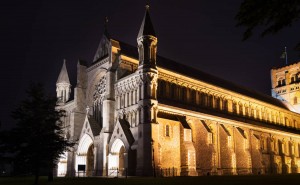
Image: Anna Moskvina/Shutterstock.com
St Albans Cathedral, formerly a church, formerly an abbey, is open to the public and is a spectacular sight. It boasts the title of being home to the first saint in Britain. The cathedral has many events throughout the year and entry is free, which attracts countless pilgrims. They do ask for a donation and it’s a nice gesture if you enjoyed the visit. As the picture above shows it is equally impressive at night too.
Shaw’s Corner is the house in town where famous playwright George Bernard Shaw once lived. This was his home for more than forty years. You can walk around the preserved rooms or enjoy a stroll through the wildflower gardens.
Those who like railways can head out to St Albans South Signal Box. This brightly painted signal box is a historic site dating back to the early days of the railroad. There are many signal boxes in the area and a group tour runs regularly by train.
Outdoor Attractions
Verulamium Park, named after the Roman name for St Alban’s predecessor, is a permanently enjoyable feature n the heart of town. It sports an enormous ornamental lake and Roman ruins for you to browse. There are green areas and picnic benches, as well as plenty of demanding ducks that need your attention. It also offers a chocolate box view of the Cathedral for those who like taking photos.
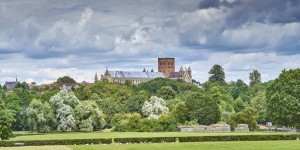
Image: Matthew J Thomas/Shutterstock.com
Another firm favourite among locals is to take a trip out to the ancient woodland of Heartwood Forest. This woodland has a remarkable bluebell blanket in May, with plenty of wildlife to spot and nature to get lost in. This area is ideal for dog walkers and for those with small children who need somewhere to let them exhaust themselves. Please bring your litter home so others can enjoy it.
Galleries and Museums
The Verulamium Museum holds all the information on the history of the Roman era in St Albans that you need to know about. It’s a Roman life museum that has a fantastic selection of mosaic floors. There is another mosaic that you can find in the nearby park described above. Although the park mosaic is free there is a small charge for the museum. It’s worth it though, don’t worry.
Although not technically a museum, the Redbournbury Watermill and Bakery is a tourist attraction that millions have loved. The mill has its own shop, and the bakery is attached. They offer bakery classes, teambuilding and run a farmer’s market stall.
If you want to know about the history of the city, pop into the St Albans Museum and Gallery to peruse some fine art.
There is the De Havilland Aircraft Museum too, for those that enjoy learning about aeroplanes. Aircraft have been built here since before the Second World War, and there are plenty of exhibits as a result.
Sports and Recreation
St Albans have their own football team called St Albans City FC. You can find them playing weekly matches at Clarence Park which is too big to miss.
This being an English city, you have three golf clubs dotted around town. Attend the Batchwood golf course and sports centre, the Abbey View golf course, or the Verulam Golf Club.
Other Notable St Albans Attractions
We couldn’t fit a million attractions in St Albans into one article – but we tried our best! Here are the things that we missed…
- Willows Activity Farm is fantastic for the kiddies.
- Aylett Nurseries are a great place to go to peruse some plants.
- Get some pictures taken at St Albans Clock Tower.
- Check out the Farmer’s Market.
- Follow St Alban’s Way
- Have a look at St Albans Organ Museum, which is exactly as odd as it sounds.
So, get out there and get exploring, there’s a whole city waiting.
How to Get to St Albans?
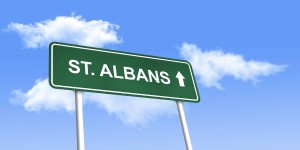
Image: Max Sky/Shutterstock.com
Now that we have whet your appetite, let’s give you some brief directions.
By Road
Follow the M1 north out of London and you will soon see signs.
By Rail
Look for St Albans City, although you can get off at the Abbey, too.
By Air
London Luton airport is the nearest.
By Sea
Unfortunately, there is no easy way, but Bell Wharf Beach (Essex) is situated about 45 miles south east so you could anchor up there and get a taxi we suppose. Well, we like to cover all the bases here.
More from Five Minutes Spare
Are you looking for the best place to go on holiday this year? We have reviewed hundreds of towns and cities around the UK for your amusement. Hop over to our travel section and browse till your heart, and your sense of adventure is content.
